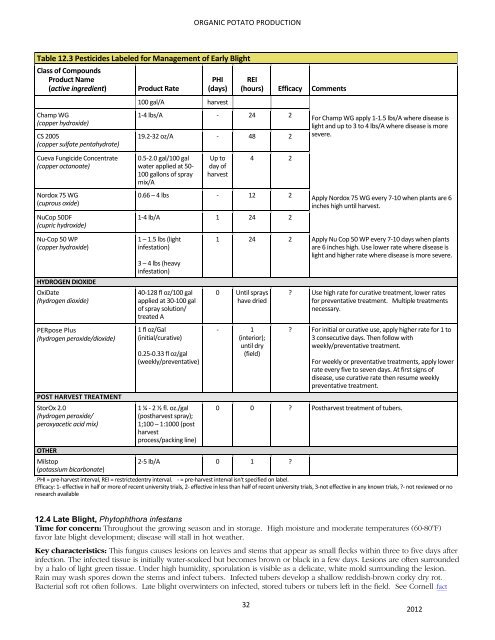potato 5-9-12 CLEAN - Vegetableipmasia.org
potato 5-9-12 CLEAN - Vegetableipmasia.org
potato 5-9-12 CLEAN - Vegetableipmasia.org
Create successful ePaper yourself
Turn your PDF publications into a flip-book with our unique Google optimized e-Paper software.
ORGANIC POTATO PRODUCTION Table <strong>12</strong>.3 Pesticides Labeled for Management of Early Blight Class of Compounds Product Name (active ingredient) Product Rate PHI (days) 100 gal/A harvest REI (hours) Efficacy Comments Champ WG (copper hydroxide) CS 2005 (copper sulfate pentahydrate) 1-‐4 lbs/A -‐ 24 2 19.2-‐32 oz/A -‐ 48 2 For Champ WG apply 1-‐1.5 lbs/A where disease is light and up to 3 to 4 lbs/A where disease is more severe. Cueva Fungicide Concentrate (copper octanoate) 0.5-‐2.0 gal/100 gal water applied at 50-‐100 gallons of spray mix/A Up to day of harvest 4 2 Nordox 75 WG (cuprous oxide) NuCop 50DF (cupric hydroxide) 0.66 – 4 lbs -‐ <strong>12</strong> 2 1-‐4 lb/A 1 24 2 Apply Nordox 75 WG every 7-‐10 when plants are 6 inches high until harvest. Nu-‐Cop 50 WP (copper hydroxide) HYDROGEN DIOXIDE OxiDate (hydrogen dioxide) 1 – 1.5 lbs (light infestation) 3 – 4 lbs (heavy infestation) 40-‐<strong>12</strong>8 fl oz/100 gal applied at 30-‐100 gal of spray solution/ treated A 1 24 2 Apply Nu Cop 50 WP every 7-‐10 days when plants are 6 inches high. Use lower rate where disease is light and higher rate where disease is more severe. 0 Until sprays have dried ? Use high rate for curative treatment, lower rates for preventative treatment. Multiple treatments necessary. PERpose Plus (hydrogen peroxide/dioxide) POST HARVEST TREATMENT StorOx 2.0 (hydrogen peroxide/ peroxyacetic acid mix) OTHER Milstop (potassium bicarbonate) 1 fl oz/Gal (initial/curative) 0.25-‐0.33 fl oz/gal (weekly/preventative) 1 ¼ -‐ 2 ½ fl. oz./gal (postharvest spray); 1;100 – 1:1000 (post harvest process/packing line) -‐ 1 (interior); until dry (field) 2-‐5 lb/A 0 1 ? ? For initial or curative use, apply higher rate for 1 to 3 consecutive days. Then follow with weekly/preventative treatment. For weekly or preventative treatments, apply lower rate every five to seven days. At first signs of disease, use curative rate then resume weekly preventative treatment. 0 0 ? Postharvest treatment of tubers. 59B PHI = pre-‐harvest interval, REI = restrictedentry interval. -‐ = pre-‐harvest interval isn't specified on label. Efficacy: 1-‐ effective in half or more of recent university trials, 2-‐ effective in less than half of recent university trials, 3-‐not effective in any known trials, ?-‐ not reviewed or no research available <strong>12</strong>.4 Late Blight, Phytophthora infestansTime for concern: Throughout the growing season and in storage. High moisture and moderate temperatures (60-80 o F)favor late blight development; disease will stall in hot weather.Key characteristics: This fungus causes lesions on leaves and stems that appear as small flecks within three to five days afterinfection. The infected tissue is initially water-soaked but becomes brown or black in a few days. Lesions are often surroundedby a halo of light green tissue. Under high humidity, sporulation is visible as a delicate, white mold surrounding the lesion.Rain may wash spores down the stems and infect tubers. Infected tubers develop a shallow reddish-brown corky dry rot.Bacterial soft rot often follows. Late blight overwinters on infected, stored tubers or tubers left in the field. See Cornell HUfact3220<strong>12</strong>




![Section 4 [ PDF file, 252 KB] - The Field Alliance](https://img.yumpu.com/51387260/1/158x260/section-4-pdf-file-252-kb-the-field-alliance.jpg?quality=85)











